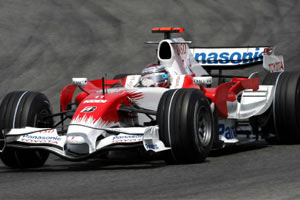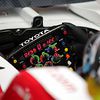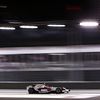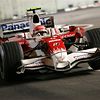Toyota TF108

Active: 2008
Team: Toyota Motorsports GmbH
Team: Pascal Vasselon (TD), Luca Marmorini (HE)
Drivers: Jarno Trulli (11), Timo Glock (12)
Toyota launched their TF108 at their home base in Cologne on 10 January. The car marks the end of a traditional design approach that Toyota had followed and is a completely different concept: "The aerodynamic concept of this car has changed", said Pascal Vasselon at the launch. "The TF107 was an evolution of the TF106 but this time the new package is a departure from recent Toyotas. The primary aerodynamic design philosophy for the TF108 is geared towards optimising the entire package to minimise balance and downforce changes throughout a lap, thereby producing a more driveable, aerodynamically robust car. In addition to the aerodynamic philosophy, another fundamental change is the wheelbase, which is longer. In mechanical terms we felt we had a strong basis in the TF107’s characteristics so we have focused on making a few refinements. We have made refinements to improve the weight over stiffness ratio with better structural efficiency, so we achieve the same stiffness values with less weight."
The different approach also shows in the car's looks. At the front, the TF108 features a bridge wing that follows the concept introduced by McLaren. The wing attaches to an unchanged nose cone that was introduced back at the Turkish GP in 2007.
At both sides of the hub, Toyota have also clearly put considerable effort in managing airflow around the sidepods. The team has had a history of fitting its cars with a combination of small turning vanes, while the TF108 has full-sized barge boards, just like all cars that were ahead of the team in 2007.
Along with the design trends of the sidepods since 2003, the radiator positions have been changed and the sidepods were slimmed down to allow a cleaner airflow towards the rear wing. The shark gills to help cooling were retained while the flipups ahead of the rear wheels have a more temporate look thanks to a simpler design.
Another unexpected change was the move to outboard mirrors, which at the launch were designed to attach to the sidepod panels. By the first race however, the team reverted to its 2007 mirrors, only to replace them again as of the Spanish GP with outboard mirrors similar to Ferrari's design.
Apart from aerodynamic challenges, the team also faced the standard ECU that needed to be fitted into the RVX-08. Contrary to the previously used Magnetti Marelli system, the SECU is identical for every team, requiring the teams to adapt to the system instead of the other way around. Luca Marmorini stated at the car's launch that the cost saving target was certainly not realised by the standard ECU as Toyota spent equal or more resources to fitting the ECU onto the existing compared to developing a completely new engine.
Apart from the car itself, the team also started with a new driver lineup. Newcomer Timo Glock replaces Ralf Schumacher and joins Jarno Trulli.
Development timeline
- Oct 2006: Project group established to start investigating TF108 concept, mainly from simulation point of view.
- Dec 2006: First design decisions taken regarding TF108, including major dimensions, such as the wheelbase.
- Jan 2007: Detailed work begins in earnest on designing the TF108, with the gearbox as first priority.
- Mar 2007: Wind tunnel testing of TF108 begins.
First example of standard ECU arrives. - Jul 2007: Standard ECU runs on the dyno for the first time.
First track tests without traction control in preparation for 2008 ban. - Sep 2007: Development of TF107 stops, with all focus on TF108.
- Nov 2007: Standard ECU runs for the first time in a car on track, at Barcelona, together with TF108 rear end (gearbox and suspension).
- Jan 2008: TF108 to run on track for the first time, at Jerez on January 13.
Specifications
Monocoque: Moulded carbon fibre and honeycomb construction.
Fuel tank: ATL safety cell
Suspension: Carbon fibre double wishbone arrangement, with carbon fibre trackrod and pushrod.
Dampers: Penske
Wheels: BBS forged magnesium
Tyres: Bridgestone Potenza
Brakes: Brembo callipers and master cylinders, Hitco material (carbon/carbon)
Steering: Toyota power-assisted steering. Toyota carbon fibre steering wheel with Toyota/Magneti Marelli instruments
Driver’s seat: Carbon fibre
Restraints: Takata
HANS device: Hubbard-Downing
Electronics: Toyota, Magneti Marelli plus McLaren Electronics Systems ECU (as required by FIA rules)
Transmission: 7-speed unit plus reverse
Dimensions
Overall length: 4636 mm
Overall height: 950mm
Overall width: 1800mm
Overall weight: 605kg inc driver and camera
Engine
Designation: Toyota RVX-08
Type: 90° V8
Capacity: 2,398cc
Horsepower: Approximately 740bhp
Revolutions: Maximum 19,000rpm (as required by FIA rules)
Valve actuation: Pneumatic
Throttle actuation: Hydraulic
Spark Plugs: DENSO
Fuel: Esso
Lubricants: Esso








